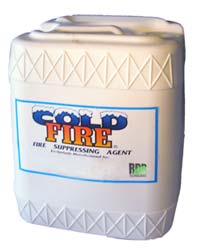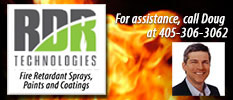
Cold Fire – Special Attributes
 After Cold Fire™ is applied to a structure it remains wet for forty-five minutes. There is field experience indicating that once dry there may be extended protection. Gels can dry in a few hours and become ineffective unless rehydrated.
After Cold Fire™ is applied to a structure it remains wet for forty-five minutes. There is field experience indicating that once dry there may be extended protection. Gels can dry in a few hours and become ineffective unless rehydrated.- Cold Fire™ can be used with fresh or salt water
- Unlike gels that form a very slippery film on horizontal platforms, steps, etc., and can be trackedinto a residence, Cold Fire™ is essentially unnoticeable.
- Unlike some products Cold Fire™ will not damage structural paint surfaces or roofing materials, is not an eye or skin irritant, and will not clog valves, eductors or diminish the range of the hose-nozzle spray pattern.
- Cold Fire™ has been tested successfully under the purview of MTDC (Missoula, Montana) for surface and intergranular corrosion of aluminum. This feature is important when using this product for aerial applications.
- The policy of the Forest Service to allow “let burn” is important to restoration of our forests. Cold Fire™ can provide the necessary adjustment of fire movement and control burn patterns to support this policy.
- Cold Fire™ will not influence the investigation scene of suspected arson. Unlike other fire fighting materials which may mask the evidence, it has been noted that the olfactory faculties of animals normally used in the investigation are not affected by the use of Cold Fire.
- Cold Fire™ can be used not only for structure protection but as the primary fire-fighting agent, unlike gels. In addition, this single product provides the capability to handle class A, B and D fires.
- Cold Fire™ can be stored indefinitely. It has passed the freeze/thaw cycle test without detriment to product performance. Many other products separate or otherwise lose effectiveness and must be stored in protective environments to prevent a freeze situation or excessive heat and/or moisture exposure.
- Because Cold Fire never expires, can put out ANY fire, can be used in low percentages, requires less cleanup, and puts the fire out faster, it is the most economical choice when using fire suppressing agents.
